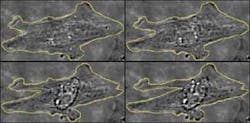CELL BIOLOGY: Laser pacemaker explores secrets of the heart
A research team at Osaka University in Japan has shown that cultured heart-muscle cells synchronize their contractions in response to pulses from a femtosecond laser.1 The effect, which works on groups of up to ten cells as well as individual cells, could provide insights into the nature of and potential treatments for abnormal heart rhythms.
The project stemmed from a study of the role of calcium in regulating the heart-muscle cells called cardiomyocytes. The Osaka team, headed by Nicolas Smith, used femtosecond-laser pulses to cause leaks from cells’ stores of calcium and thereby to synchronize the cells’ beat frequencies (see figure). In effect, Smith says, the group created a laser pacemaker for the cells.
Smith worked with cultured cardiomyocyte cells from newborn rats. During the culturing process, his team introduced a fluorescent tag, Fluo-4, intended to reveal cellular contractions under the fluorescence microscope. The researchers fired a Ti:sapphire laser that emitted 80 fs pulses at a 780 nm wavelength at single cells and groups of two to ten cells. In the optimal conditions of average laser power from 15 to 30 mW, between a quarter and a half of the cells synchronized their contraction to the laser pulses. The fact that not all cells synchronize “is not surprising,” Smith says, “when you consider that the cell and the laser both have variable frequency and the location of the laser spot in the cell will be slightly different for each cell.”
Avenues for further research
The result suggests several avenues for further research. “It would be good to look closely at the differences between atrial and ventricular myocytes, which are cardiomyocytes from different parts of the heart,” Smith says. “These different cell types work in tandem in the heart but have distinct physiology and have well-known differences in calcium dynamics. Since calcium is fundamental to the laser-cell interaction that we observe, we would like to know more about how the pacemaking effect changes in these different cell types. We think that we can also use the laser effect to destabilize existing contractions in groups of synchronized cardiomyocytes. Then we can look at how the abnormal contraction in the cell targeted by the laser affects the adjacent cells.”
The research may help understand abnormal heart rhythms in humans. “Although we are not heart specialists, we think that the propagation of abnormal contraction from the target cell to the surrounding cells gives a picture of how abnormal heart contraction can start on a cellular level,” Smith says, adding that it may improve the understanding of resistance to fibrillation.
REFERENCE
1. N. I. Smith et al., Optics Express 16(12) 8604 (May 28, 2008).
Peter Gwynne | Freelance writer
Peter Gwynne is a freelance writer based in Massachusetts; e-mail: [email protected].
